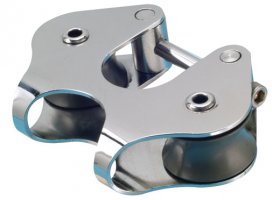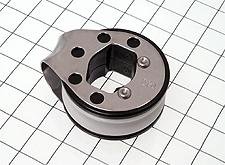I have the orig 1989 Navtec hydraulic backstay, works fine.
This is the first time I've had one on a boat, didn't even know there was a # pressure gauge on it . My slip partner said you should use between 2,000 & 2,500# pressure.
. My slip partner said you should use between 2,000 & 2,500# pressure.
Also...I recently had my standing rigging replaced...prior to that, I had the rigger tune my orig 1989 Harken roller furling unit which worked marginally better after the tune up. Last Sun I was on SF Bay in 26 knots of wind, dropped the headsail sheet and couldn't hardly get the headsail to furl.
Why? My dock buddy, who is a surveyor said #1 I had to little back stay tension as I think I was at about 1,000#, #2 with 8-10" of sag, the unit would almost never furl. We rolled it out in 15 knots at he dock and were at a perfect starboard tack . After checking to see that the top and bottom drums were moving freely, he felt the only other mechanical problem might be an elongated foil.
. After checking to see that the top and bottom drums were moving freely, he felt the only other mechanical problem might be an elongated foil.
So...I call Harken...the dude said the back stay has very little to do with the forestay unless your in one of those little J boats or some such. Also, it was very unlikely that the Harken foil had elongated. His guess would be that the rigger left the forestay to loose and needs to tighten it up.
So:
A) What is the proper tension for the hydraulic backstay.
B) What caused the furling unit to not furl.
C) If it is the riggers fault, considering the sail has been damaged due to the excessive flogging, do you think they are responsible for the repair considering it will probably be a $300 or so repair bill?
Thoughts and opinions are welcome and respected.
Thanks -
Jay
Celtica
SF Bay
This is the first time I've had one on a boat, didn't even know there was a # pressure gauge on it
Also...I recently had my standing rigging replaced...prior to that, I had the rigger tune my orig 1989 Harken roller furling unit which worked marginally better after the tune up. Last Sun I was on SF Bay in 26 knots of wind, dropped the headsail sheet and couldn't hardly get the headsail to furl.
Why? My dock buddy, who is a surveyor said #1 I had to little back stay tension as I think I was at about 1,000#, #2 with 8-10" of sag, the unit would almost never furl. We rolled it out in 15 knots at he dock and were at a perfect starboard tack
 . After checking to see that the top and bottom drums were moving freely, he felt the only other mechanical problem might be an elongated foil.
. After checking to see that the top and bottom drums were moving freely, he felt the only other mechanical problem might be an elongated foil.So...I call Harken...the dude said the back stay has very little to do with the forestay unless your in one of those little J boats or some such. Also, it was very unlikely that the Harken foil had elongated. His guess would be that the rigger left the forestay to loose and needs to tighten it up.
So:
A) What is the proper tension for the hydraulic backstay.
B) What caused the furling unit to not furl.
C) If it is the riggers fault, considering the sail has been damaged due to the excessive flogging, do you think they are responsible for the repair considering it will probably be a $300 or so repair bill?
Thoughts and opinions are welcome and respected.
Thanks -
Jay
Celtica
SF Bay

 I don't have a lot of hours with a roller furling. If everyone says it, that's good enough for me. Question though...are you saying to leave pressure on the sheet? If you 'blow out' the sheet, the genoa will flog, right?
I don't have a lot of hours with a roller furling. If everyone says it, that's good enough for me. Question though...are you saying to leave pressure on the sheet? If you 'blow out' the sheet, the genoa will flog, right? ) then started to tack to try to relieve the pressure.
) then started to tack to try to relieve the pressure.
